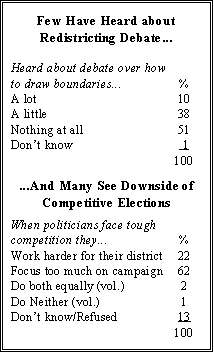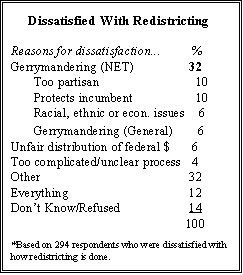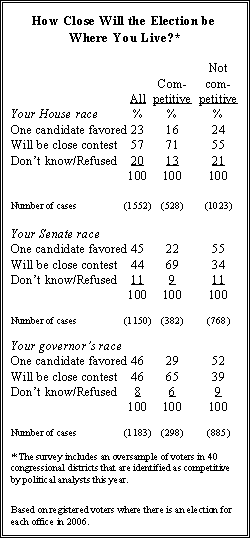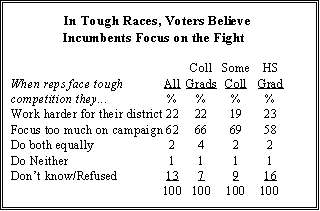
The concern among some politicians and political experts over the lack of competitiveness in U.S. elections is generally not shared by the public. Moreover, voters appear to lack a clear sense of whether the elections in their own House districts are competitive or not.
The public is only dimly aware of the debate over how boundaries are drawn for legislative districts. Just 10% of Americans say they have heard a lot about this issue compared with 89% who have heard little (38%) or nothing (51%) about it.
And while 71% of voters in districts where there are competitive House elections this year say the race is close in their district, a majority of voters (55%) in non-competitive districts also think their local House races are close.1 There is much greater awareness of the competitive situation in Senate and gubernatorial races.
The latest survey by the Pew Research Center for the People & the Press, in association with the Brookings Institution and the Cato Institute, also shows that most Americans see a downside in electoral competition. Just 22% say that when politicians face tough competition for reelection it makes “them work harder to represent their district better.” By contrast, 62% say that tough reelection campaigns make politicians “focus too much on fundraising and campaigning instead of being a good representative.”
Little Awareness of Redistricting Process

The survey, conducted Oct. 17-22 among 1,552 registered voters (2,006 adults) finds that not only is the debate over the redistricting process “below the radar” for most people, a majority of the public is unaware of who controls the process in their states. Although the vast majority of Americans live in a state where elected officials have the final responsibility for redistricting, just 44% are aware of this. Nine percent believe redistricting is done by a nonpartisan panel, and 47% say they don’t know.
Given the lack of public familiarity with the process and the debates about it, it is not surprising that most people have no opinion when asked whether they are satisfied or dissatisfied with how redistricting is conducted in their state. Overall, 13% say they are satisfied, 14% are dissatisfied, and 70% say they have no opinion. Democrats (18% dissatisfied) are less happy with the process than are Republicans (11% dissatisfied).

The small number who expressed dissatisfaction with the redistricting process were asked why they feel this way. The plurality of responses (32%) cited some aspect of gerrymandering partisan outcomes, incumbent protection, the creation of safe districts for minorities, and the like. Other reasons cited by respondents included the belief that the process leads to an unfair distribution of resources, that the process is too complicated, or that the public has no say in how it’s done.
Do Voters Know if Their Elections are Competitive?
While most of the public knows little about the debate over redistricting, they are somewhat better informed about the level of competition in the elections for which they are eligible to vote, especially those at the statewide level. Most voters who live in states with competitive senate and governor’s races are aware that those races are closely contested 69% in states with close senate races and 65% in states with close gubernatorial races.

Somewhat fewer though still a majority of those living in states where the senate or governor’s race is one-sided realize that the race is not competitive. In states without a close senate race, 55% know that one candidate is heavily favored; in states without a close governor’s race, 52% know this.
Voters are less aware of the level of competition in races for the U.S. House. Those who live in competitive districts are more likely than others to say that their race is likely to be close (71% say this), but even in non-competitive districts, majorities of voters think the race is tight (55%). This perception could be accurate in many of the Republican-held districts not on the list of competitive races, given that Pew’s polling shows Democratic candidates doing well in many districts other than the most competitive ones. But voters in safe Democratic districts, where the Democratic advantage in the generic ballot is overwhelming, have essentially the same perceptions about the competitiveness of the races: 54% say the race is close, 26% say one candidate is heavily favored.
Satisfaction With Electoral Choices
Voters are divided over the question of whether the electoral choices available to them this year are satisfactory or not. A bare majority of 51% is satisfied, while 43% say they wish there were other choices. This reflects slightly more satisfaction with the alternatives than in 1994, when 45% were satisfied and 47% dissatisfied, and a somewhat greater change from 1990 (41% satisfied, 54% not). Voters who live in places with competitive races whether House, senate, or governor’s are no more satisfied with the choices than those who do not have competitive races.

But satisfaction with the alternatives does differ across certain groups in the population. Independents, in particular, are more likely to want other choices than are Democrats or Republicans. Nearly six-in-ten independents (58%) say they would like alternatives, compared with just 33% of Republicans and 39% of Democrats. Blacks are less satisfied with the electoral choices they have than are whites.
Is Competition a Good Thing?
While the principle of open competition underlies America’s free enterprise system and its system of elections, not all aspects of electoral competition are viewed positively by the general public. Not surprisingly, most people who identify with a political party want their party to win. Respondents in the poll were asked which party wins most elections where they live. Overall, 28% said Republicans win most elections, 21% said the Democrats win most elections, and 39% said a mix of each do so. Over two-thirds of Democrats (67%) and Republicans (68%) who claimed that their own party wins most elections said they thought this was a good thing. And most who said the other party wins most elections said it was a bad thing (77% among Democrats, 64% among Republicans).
Still, many people prefer that a mix of each party wins. Among those who say that this is the pattern in their own area, 60% or more regardless of party say this is a good thing. People who feel this way constitute over one-quarter (27%) of all respondents to the poll.

Respondents were also asked about the impact of electoral competition on the behavior of politicians. When asked to choose between two alternatives, a solid majority (62%) said that tough competition leads politicians to focus too much on campaigning and fund raising; just 22% said it made politicians work harder to represent their districts better. College-educated respondents were more likely than those with just a high school education to believe that tough competition makes politicians focus too much on campaigning.
Notes
1The competitive House districts were identified using rankings from early to mid-October in Congressional Quarterly, The Cook Political Report, The Rothenberg Political Report, The New York Timess, and Larry Sabato’s Crystal Ball.




